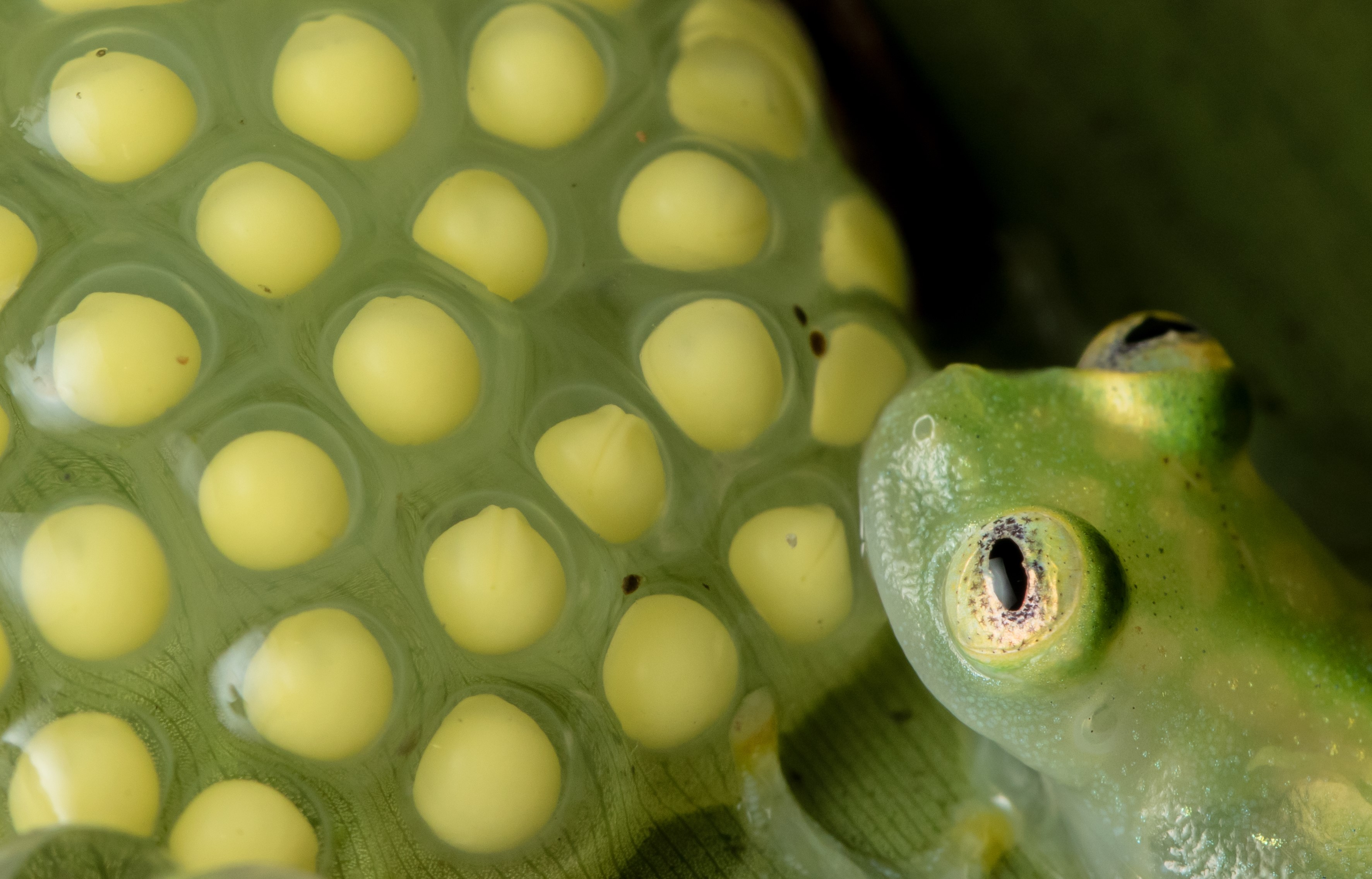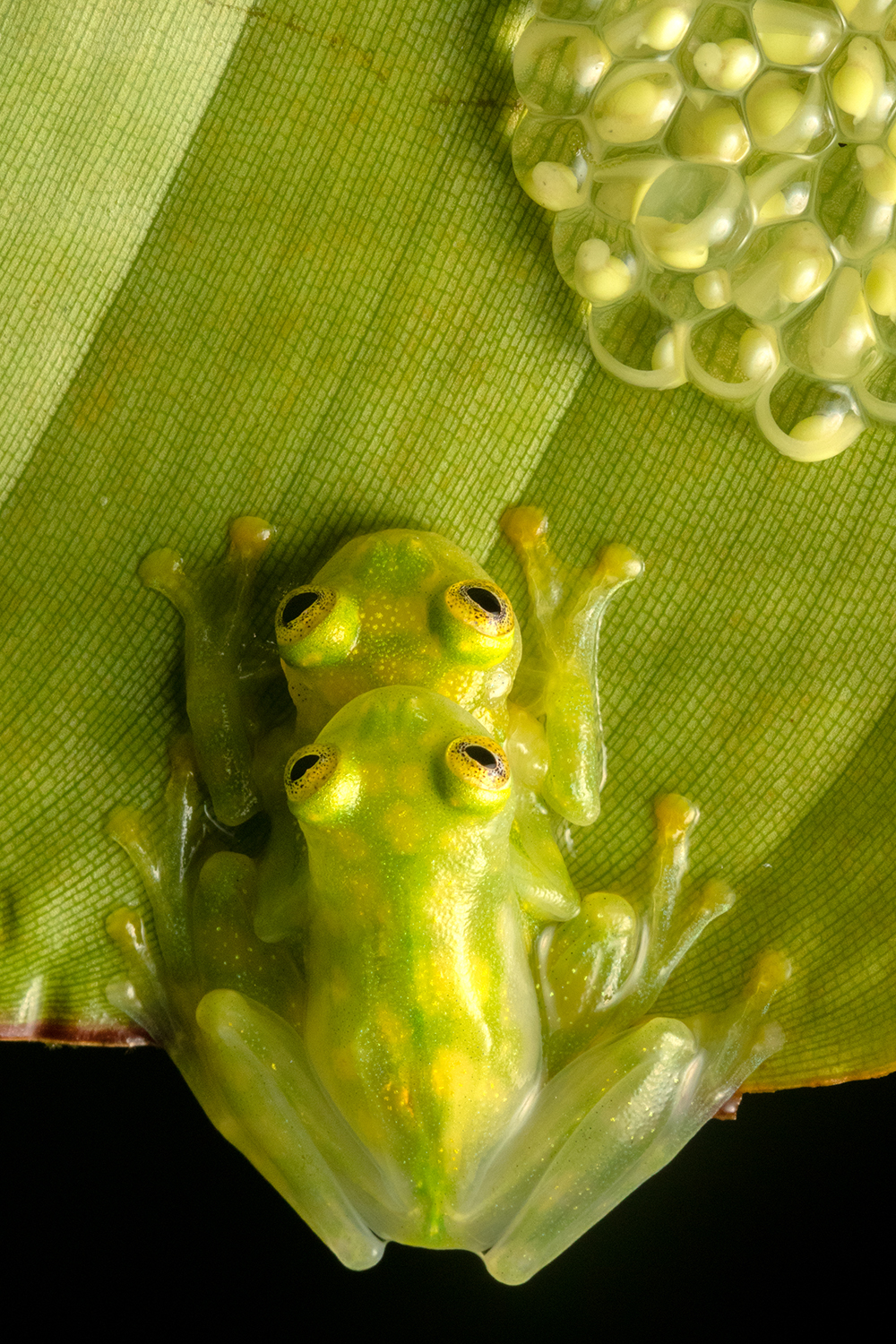Caring glassfrog fathers have smaller testes
An international team of researchers including the University of Bern shows in a new study that male glassfrogs that care for their offspring have smaller testes than males of species that do not provide any brood care. This indicates an evolutionary trade-off between sperm production and parenting.
Living in the tropical rainforests of Central and South America, frogs of the glassfrog family are fascinating because of their transparent skin on their belly, which reveals their internal organs. However, it is not only the appearance of these amphibians that is remarkable, but also their social behavior. In many - but not all - glassfrog species, the males remain with the clutch after mating and guard and care for their offspring. In a new study, an international team, including researchers from the Institute of Ecology and Evolution at the University of Bern, shows that there is a link between this paternal care and the testes size of glassfrogs. The results were recently published in the journal Proceedings of the Royal Society B.
37 different species of glassfrogs
"The study involved several months of field research in the rainforests of Brazil and Ecuador, collecting data on the behavior and physical characteristics of different species of glassfrogs," says Eva Ringler, Professor and Head of the Department of Behavioral Ecology at the Institute of Ecology and Evolution at the University of Bern. The researchers also performed a phylogenetic analysis of the entire glassfrog family tree. Such analysis can provide key information about evolutionary transitions in certain physical as well as behavioral traits, as for example parental care. A total of 37 different glassfrog species were studied. In 11 of these species, males care for their offspring; in the others, males do not provide any brood care. "Our study is an important contribution to a better understanding of the evolution of male parenting," says Cynthia Prado, last author of the study and professor at São Paulo State University.
An evolutionary trade-off
In the study, the team showed that male glass frogs that care for their offspring have proportionally smaller testes than males of species that do not care for their offspring. These findings shed light on the various strategies that different species use to maximize their reproductive success. "Our results suggest an evolutionary trade-off between testes size and paternal care in glassfrogs," explains Anyelet Valencia Aguilar, first author of the study, who until recently worked at the Institute of Ecology and Evolution at the University of Bern and is now conducting research at the Justus Liebig University in Giessen as part of a Swiss National Science Foundation (SNSF) postdoctoral mobility grant. To explain this trade-off, it is important to know that in glassfrogs, as in all amphibians, the female's eggs are fertilized externally: During mating, the female releases unfertilized eggs on which the male immediately deposits his sperm.
This external fertilization carries the risk of "clutch piracy": male frogs that manage to get their sperm onto a fresh clutch of eggs, thus fertilizing those eggs that have not yet been fertilized by the sperm of the original male. "When a male guards his clutch, he reduces the risk of fertilization by other males and thus reduces the selective pressure for increased sperm production – leading to relatively smaller testes of males in species that perform brood care. Our study thus highlights the important role of paternal care in the evolution of testes size in species with external fertilization," Ringler says.
Similar patterns known in primates
"We were surprised how clear these trade-offs are present in glassfrogs," says Ringler. Previously, such evolutionary relationships between male genitalia and reproductive behavior were mainly known in primates: Males of harem-forming species have big body sizes and strength to keep rivals away, which also leads to smaller genitalia because they primary access to mating with females in their group. In contrast, males of species that live in mixed-sex groups with promiscuous mating have relatively large genitalia to maximize fertilization success, as large genitalia are usually associated with large sperm production. In these species, male-male competition does not take place before mating, but rather afterwards, at the sperm level. "It is very exciting to find similar evolutionary relationships in glassfrogs. In recent years, it has become evident that there are still so many fascinating aspects to be discovered about glassfrogs," says Ringler.
Glassfrog research continues: As part of a research project funded by the Swiss National Science Foundation (SNSF), Eva Ringler and her team are currently investigating the relationships between parental care behavior, spatial use, cognition and communication in various glassfrog species. "We still know very little about the social and reproductive behavior of many species and the associated cognitive abilities. Our project should make an important contribution to a better understanding of the relationships between behavior, reproduction and cognition," Ringler concludes.
The study was financially supported by the São Paulo Research Foundation (FAPESP), the Universidad San Francisco de Quito (USFQ) and the Swiss National Science Foundation (SNSF).
Publication details:Valencia-Aguilar A, Ringler E, Lüpold S, Guayasamin JM, Prado CPA. 2024. Evolutionary trade-offs between testes size and parenting in Neotropical glassfrogs. Proc. R. Soc. B 291: 20240054. https://doi.org/10.1098/rspb.2024.0054 |
The Institute of Ecology and EvolutionThe Institute of Ecology and Evolution at the University of Bern is devoted to research and teaching in all aspects of ecology and evolution, and aim to provide a scientific basis for the understanding and preservation of our living world. The mechanisms by which organisms respond to and interact with their environment are studied, including phenotypic responses at individual level, change in gene frequencies at population level, change in species composition and abundance at community level, and the functioning of whole ecosystems. More information |
2024/02/22





